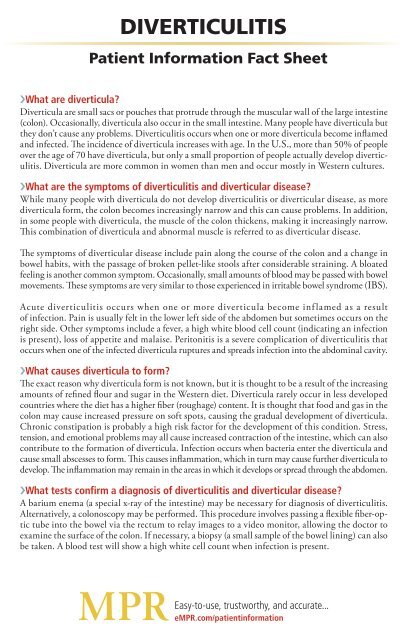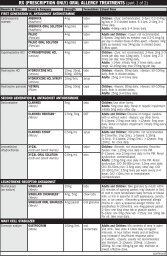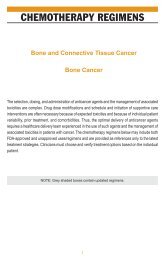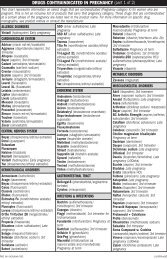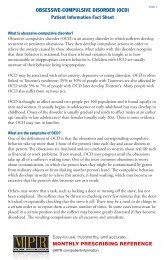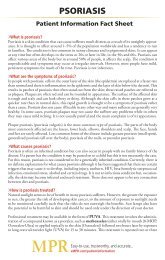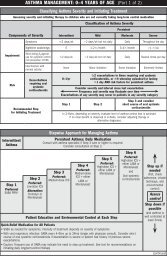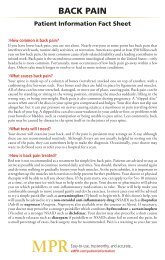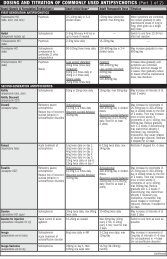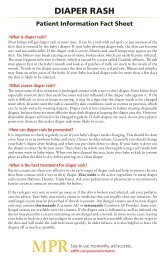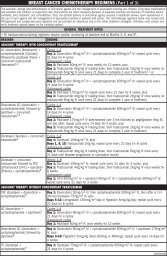Diverticulitis - MPR
Diverticulitis - MPR
Diverticulitis - MPR
You also want an ePaper? Increase the reach of your titles
YUMPU automatically turns print PDFs into web optimized ePapers that Google loves.
<strong>Diverticulitis</strong><br />
Patient Information Fact Sheet<br />
›What are diverticula?<br />
Diverticula are small sacs or pouches that protrude through the muscular wall of the large intestine<br />
(colon). Occasionally, diverticula also occur in the small intestine. Many people have diverticula but<br />
they don’t cause any problems. <strong>Diverticulitis</strong> occurs when one or more diverticula become inflamed<br />
and infected. The incidence of diverticula increases with age. In the U.S., more than 50% of people<br />
over the age of 70 have diverticula, but only a small proportion of people actually develop diverticulitis.<br />
Diverticula are more common in women than men and occur mostly in Western cultures.<br />
›What are the symptoms of diverticulitis and diverticular disease?<br />
While many people with diverticula do not develop diverticulitis or diverticular disease, as more<br />
diverticula form, the colon becomes increasingly narrow and this can cause problems. In addition,<br />
in some people with diverticula, the muscle of the colon thickens, making it increasingly narrow.<br />
This combination of diverticula and abnormal muscle is referred to as diverticular disease.<br />
The symptoms of diverticular disease include pain along the course of the colon and a change in<br />
bowel habits, with the passage of broken pellet-like stools after considerable straining. A bloated<br />
feeling is another common symptom. Occasionally, small amounts of blood may be passed with bowel<br />
movements. These symptoms are very similar to those experienced in irritable bowel syndrome (IBS).<br />
Acute diverticulitis occurs when one or more diverticula become inflamed as a result<br />
of infection. Pain is usually felt in the lower left side of the abdomen but sometimes occurs on the<br />
right side. Other symptoms include a fever, a high white blood cell count (indicating an infection<br />
is present), loss of appetite and malaise. Peritonitis is a severe complication of diverticulitis that<br />
occurs when one of the infected diverticula ruptures and spreads infection into the abdominal cavity.<br />
›What causes diverticula to form?<br />
The exact reason why diverticula form is not known, but it is thought to be a result of the increasing<br />
amounts of refined flour and sugar in the Western diet. Diverticula rarely occur in less developed<br />
countries where the diet has a higher fiber (roughage) content. It is thought that food and gas in the<br />
colon may cause increased pressure on soft spots, causing the gradual development of diverticula.<br />
Chronic constipation is probably a high risk factor for the development of this condition. Stress,<br />
tension, and emotional problems may all cause increased contraction of the intestine, which can also<br />
contribute to the formation of diverticula. Infection occurs when bacteria enter the diverticula and<br />
cause small abscesses to form. This causes inflammation, which in turn may cause further diverticula to<br />
develop. The inflammation may remain in the areas in which it develops or spread through the abdomen.<br />
›What tests confirm a diagnosis of diverticulitis and diverticular disease?<br />
A barium enema (a special x-ray of the intestine) may be necessary for diagnosis of diverticulitis.<br />
Alternatively, a colonoscopy may be performed. This procedure involves passing a flexible fiber-optic<br />
tube into the bowel via the rectum to relay images to a video monitor, allowing the doctor to<br />
examine the surface of the colon. If necessary, a biopsy (a small sample of the bowel lining) can also<br />
be taken. A blood test will show a high white cell count when infection is present.<br />
Easy-to-use, trustworthy, and accurate...<br />
e<strong>MPR</strong>.com/patientinformation
<strong>Diverticulitis</strong><br />
Patient Information Fact Sheet<br />
page 2<br />
›How is diverticulitis and diverticular disease treated?<br />
If diverticula are present but diverticulitis has not yet occurred, a change in diet can greatly help to<br />
prevent the condition from deteriorating. Eating a high-fiber diet and drinking large quantities<br />
of water will aid the movement of waste products along the bowel. This will also help to prevent the<br />
stools from becoming hard and dry, which can cause constipation and straining when passing stool.<br />
Laxatives and enemas should be avoided as these can make the condition worse. Symptoms of pain<br />
and bloating in diverticular disease may also be relieved by a high-fiber diet. However, in some<br />
people reducing the amount of fiber in the diet helps. Because the symptoms of diverticular disease<br />
are caused mainly by the muscle of the colon contracting too much an antispasmodic drug may<br />
sometimes be prescribed.<br />
In acute diverticulitis, bed rest may be necessary. Analgesics (painkillers) will be given for the pain<br />
and antibiotics to cure the infection. While infection is present, a fluid-only diet may be necessary<br />
to allow the intestine to rest and heal. Nutritionally fortified drinks may be prescribed to ensure<br />
an adequate diet and prevent malnourishment.<br />
Some people may need surgery and other treatments. Surgeons can clean the abdomen after<br />
infections and remove bleeding pouches and fistulas. A colon resection may be required if you get<br />
diverticulitis many times and want to avoid other infections.<br />
›Self-help measures<br />
• Eat a high-fiber diet including bread, fruit, vegetables and whole-grain cereals.<br />
• Drink plenty of fluids, particularly water.<br />
• Try to avoid constipation by always passing stool whenever there is an urge to do so.<br />
• Avoid any foods that make the symptoms worse, such as carbonated drinks and gas-forming<br />
foods like beans, cabbage, and cauliflower.<br />
›Further information<br />
National Digestive Diseases Information Clearinghouse (NDDIC):<br />
http://digestive.niddk.nih.gov/ddiseases/pubs/diverticular/index.aspx<br />
Last reviewed: May 2013<br />
Easy-to-use, trustworthy, and accurate...<br />
e<strong>MPR</strong>.com/patientinformation


